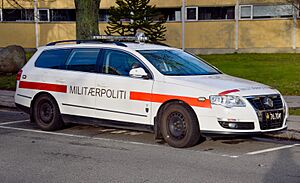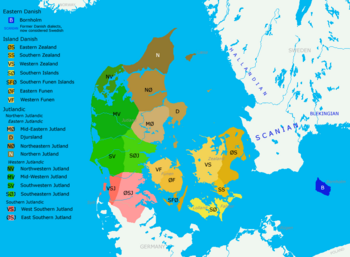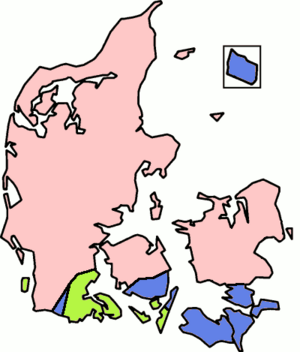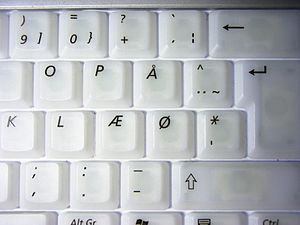Danish language facts for kids
Quick facts for kids Danish |
||||
|---|---|---|---|---|
| dansk | ||||
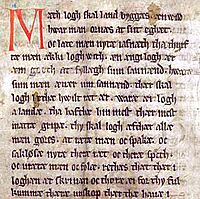
The first page of the Jutlandic Law originally from 1241 in Codex Holmiensis, copied in 1350.
The first sentence is: "Mæth logh skal land byggas" Modern orthography: "Med lov skal land bygges" English translation: "With law shall a country be built" |
||||
| Native to | ||||
| Region | Denmark, Schleswig-Holstein (Germany); Additionally in the Faroe Islands and Greenland |
|||
| Ethnicity | ||||
| Native speakers | 6.0 million (2019)e18 | |||
| Language family |
Indo-European
|
|||
| Early forms: |
Old Norse
|
|||
| Dialects |
Jutlandic
Insular
Dano-Faroese
Southern Schleswig
Perkerdansk
Dano-Norwegian †
Angel †
East Danish
South Jutlandic
|
|||
| Writing system |
|
|||
| Official status | ||||
| Official language in | Kingdom of Denmark
Nordic Council European Union |
|||
| Recognised minority language in | ||||
| Regulated by |
Dansk Sprognævn
(Danish Language Council) |
|||
| Linguasphere | 5 2-AAA-bf & -ca to -cj | |||
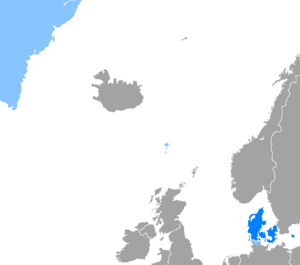
Dark Blue: Spoken by a majority Light Blue: Spoken by a minority
|
||||
|
||||
Danish ( DAY-nish; endonym: dansk dansk sprog) is a North Germanic language. It belongs to the Indo-European language family. About six million people speak Danish, mostly in Denmark and nearby areas. You can also find Danish speakers in Greenland, the Faroe Islands, and northern Germany.
Danish comes from Old Norse, which was spoken by Germanic peoples in Scandinavia during the Viking Era. Danish and Swedish are part of the East Norse group. Languages like Norwegian, Faroese, and Icelandic are in the West Norse group. Today, Danish, Norwegian, and Swedish are called "mainland Scandinavian" because they are somewhat similar. Icelandic and Faroese are "insular Scandinavian." Even though written Danish, Norwegian, and Swedish look alike, spoken Danish sounds quite different. This means it can be tricky for speakers of one to understand the others.
Before the 16th century, Danish was a mix of many different ways of speaking. There was no single "correct" way to spell or speak. When the Protestant Reformation happened and printing presses became common, a standard Danish language started to form. This new standard was based on how educated people spoke in Copenhagen and Malmö. It spread through schools and government.
Later, Danish became a symbol of Danish identity. Many important books were written in Danish in the 18th and 19th centuries. Today, the old traditional Danish ways of speaking have mostly disappeared. However, there are still regional differences in how people speak the standard language. Young people often use new and creative ways of speaking.
Danish has many different vowel sounds, about 27 of them! It also has a special sound called stød. This sound is like a little catch in your throat. Because of its unique sounds, Danish can sometimes be hard to learn and understand. Some studies even show that Danish children learn to tell sounds apart a bit slower than children learning other languages.
Danish grammar is somewhat flexible. It has regular and irregular ways to change words. Nouns and adjectives have two genders: common and neutral. Like English, Danish has only a few parts left of an old system where words changed based on their role in a sentence. Unlike English, Danish verbs don't change based on who is doing the action (like "I run," "he runs"). In Danish, the verb is always the second word in a sentence.
Contents
What is Danish?
Danish is a Germanic language. It belongs to the North Germanic group. This group is also called the Nordic or Scandinavian languages. Danish and Swedish both come from the Eastern dialects of Old Norse. They are also known as East Scandinavian or East Nordic languages.
The Scandinavian languages are often seen as a "dialect continuum." This means there are no clear lines between them. They blend into each other.
In the Middle Ages, Danish was greatly influenced by a language called Low German. Since the 1900s, English has also had a big impact on Danish.
Danish itself has three main types of dialects: Jutlandic (West Danish), Insular Danish (which includes the standard way of speaking), and East Danish. East Danish includes dialects from Bornholm and Scania. Some people think East Danish is a mix between Danish and Swedish.
How Danish Words are Built
Many Danish words come from Old Norse and even older languages. About 2,000 basic Danish words are very old.
Danish has also borrowed many words from other languages. In the Middle Ages, many words came from Low German. This is because Low German was an important language in Denmark–Norway. Later, French and standard German influenced Danish. In the 20th century, especially after World War II, English became the main source of new words.
Even though many old Nordic words remain, some were replaced by borrowed words. For example, the old Danish word for "to eat" (æde) was mostly replaced by the Low German word spise. Danish can also create new words by joining existing words together.
Danish and English are both Germanic languages. This means they share a common history. Old Norse, the ancestor of Danish, also influenced Old English a lot.
You can see this shared history in many similar words. For example, when written, words like have (have), over (over), under (under), for (for), give (give), flag (flag), salt (salt), and arm (arm) look very much like their English versions.
Some Danish words are also like words in the Scots language. For example, kirke (church) is like Scots kirk. And barn (child) is like Scots bairn. The Danish word by, meaning "village" or "town," is found in many English place names like Whitby and Selby. These names are leftovers from the Viking times. During that time, English even borrowed words like "are," "they," "them," and "their" from Old Norse.
How Danish is Related to Other Languages
Danish is mostly understandable to people who speak Norwegian and Swedish. If you speak one of these languages well, you can often understand the others. However, it's not always equal. Norwegian speakers usually understand Danish and Swedish better than Swedes or Danes understand each other. Also, Swedes and Danes understand Norwegian better than they understand each other's languages.
Norwegian is in the middle because it shares a border with Sweden, making its pronunciation similar. Also, Norwegian has a long history of using Danish as a written language, which makes their words similar. Younger Danes, especially those from Copenhagen, find it harder to understand Swedish than Danes from other parts of Denmark. Generally, young Danes are not as good at understanding neighboring languages as young people in Norway and Sweden.
Where is Danish Spoken?
In the Danish Realm, Danish is the main language of Denmark. It is also one of two official languages in the Faroe Islands, along with Faroese. There's a special Faroese way of speaking Danish called Gøtudanskt. Until 2009, Danish was also an official language in Greenland. Now, Danish is a common language in Greenland, and many native Greenlanders can speak it as a second language. About 10% of people in Greenland speak Danish as their first language.
Iceland used to be ruled by Denmark. Even though Danish stopped being an official language in Iceland in 1944, it's still widely used. It's a required subject in schools, taught after English.
Denmark doesn't have a law that says Danish is its official language. So, it's the official language de facto (meaning "in practice"). However, Danish is the language used in courts. Since 1997, government offices must follow the official spelling rules. There have been talks about making a law to officially declare Danish as Denmark's language.
There's a noticeable group of Danish speakers in Southern Schleswig, a part of Germany that borders Denmark. A type of Standard Danish is spoken there. Since 2015, the German state of Schleswig-Holstein has officially recognized Danish as a regional language. Danish is also an official language of the European Union and one of the working languages of the Nordic Council. This means Danish speakers can use their language when talking to official groups in other Nordic countries without paying for a translator.
One of the two main ways of writing Norwegian, Bokmål, is very similar to Danish. This is because standard Danish was used for government in Denmark–Norway until 1814. The other Norwegian writing style, Nynorsk, is based on Norwegian dialects. Danish also influenced North Frisian and Gutnish.
You can also find Danish-speaking communities in other parts of the world. In the Americas, there are Danish speakers in the US, Canada, Argentina, and Brazil.
Danish Dialects and Regional Speech
Standard Danish (rigsdansk) is based on the way people speak in and around Copenhagen, the capital city. Unlike Swedish and Norwegian, Danish doesn't have many different official ways of speaking in different regions. More than 25% of all Danish speakers live near Copenhagen. Most government offices and big businesses are also there. This has led to a very similar way of speaking across the country.
Traditional Danish dialects are now mostly gone. Only the oldest people still speak them. However, there are still regional ways of speaking Standard Danish. These mostly differ in pronunciation and some local words.
Danish traditional dialects are divided into three main areas:
- Insular Danish (ømål): Spoken on the Danish islands like Zealand, Funen, Lolland, Falster, and Møn.
- Jutlandic (jysk): Spoken on the Jutland peninsula, divided into North, East, West, and South Jutlandic.
- East Danish (østdansk): Includes dialects from Bornholm (bornholmsk), Scania, Halland, and Blekinge.
After Sweden took over the Eastern Danish areas of Scania, Halland, and Blekinge in the 1600s, the dialects there were heavily influenced by Swedish. Many people now speak regional versions of Standard Swedish. However, some researchers still see the dialects in Scania, Halland, and Blekinge as part of the East Danish group.
Interesting Facts About Danish Sounds
The sound system of Danish is quite unique. It has a very large number of vowel sounds. When people speak Danish quickly or informally, they often shorten unstressed syllables. This can make it sound like some words are missing vowels. Also, the way Danish sounds doesn't always give many clues about the sentence structure. These things can make Danish pronunciation hard for new learners.
One special sound feature in Danish is called stød. This word means "thrust." It's a kind of creaky voice or a slight catch in your throat. Some people used to think it was a glottal stop, but it's more like a special way of speaking certain sounds. The stød is important because it can change the meaning of words. For example, bønder (peasants) has stød, but bønner (beans) does not.
Stress is also important in Danish. It helps tell words apart, like billigst ("cheapest") and bilist ("car driver").
How Danish Grammar Works
Danish grammar has changed over time. It used to have many endings on words and a freer word order, like older European languages. Now, it has fewer endings and a more fixed word order. However, some things typical of Germanic languages remain. For example, some verbs and nouns change their vowel sound to show different forms (like fod "foot" and fødder "feet").
Nouns: Gender and Plurals
Danish nouns change their form for singular (one) or plural (more than one) and for whether they are definite (the) or indefinite (a/an). Nouns also have two grammatical genders: common and neuter. The common gender combines what used to be feminine and masculine genders. Some older dialects still have three genders.
The gender of a noun is important because it affects how adjectives change and how the definite form is made. About 75% of Danish nouns are common gender. While neuter is often for things that aren't alive, you usually have to memorize a noun's gender.
A special thing about Nordic languages like Danish is that the definite articles (like "the") are often added to the end of the noun as a suffix.
- Neuter nouns use -et at the end. For example, et hus ("a house") becomes huset ("the house").
- Common gender nouns use -en at the end. For example, en mand ("a man") becomes manden ("the man").
If a noun has an adjective, you use a separate word for "the" before the adjective:
- Jeg så et hus: "I saw a house"
- Jeg så huset: "I saw the house"
- Jeg så det store hus: "I saw the big house" (det is "the" for neuter nouns with adjectives)
For plural definite nouns, the ending is usually -(e)ne. For example, drenge ("boys") becomes drengene ("the boys").
There are three main ways to make nouns plural:
- Adding -er (indefinite) and -erne (definite). Example: bil (car) becomes biler (cars) and bilerne (the cars).
- Adding -e (indefinite) and -ene (definite). Example: hund (dog) becomes hunde (dogs) and hundene (the dogs).
- No suffix for the indefinite plural, and -ene for the definite plural. Example: fisk (fish) stays fisk (fish, plural) and becomes fiskene (the fishes).
Some nouns have irregular plurals, like mand ("man") becoming mænd ("men").
Verbs: Actions and Times
Danish verbs are quite simple. They don't change their form based on who is doing the action or how many people are doing it. Verbs have forms for past, non-past (present), and infinitive (the basic form, like "to run"). They also have participle forms (like "running" or "run") and a passive form.
Verbs are divided into two main types: strong (irregular) and weak (regular). Regular verbs add suffixes like -te or -ede to form the past tense.
- The infinitive usually ends in -e. Sometimes it's used with the word at before it, like at være ("to be").
- The non-past (present) tense usually adds -r. For example, huske ("to remember") becomes husker ("remembers").
- The past tense can be irregular, like se ("to see") becoming så ("saw").
To form the perfect tense (like "has walked"), Danish uses at have ("to have") with a past participle. But some verbs use at være ("to be") instead, especially for verbs that show movement.
- Hun har gået. ("She has walked.")
- Hun er gået. ("She has left.")
The passive form often adds -s to the verb, like avisen læses hver dag ("the newspaper is read every day").
Numbers: Counting in Danish
Danish has a unique way of counting some numbers, especially 50, 60, 70, 80, and 90. It uses a vigesimal system, which means it's based on groups of 20. This is similar to how French counts some numbers.
For numbers above 20, the units come before the tens. So, 21 is enogtyve, which literally means "one and twenty."
Here's how some of the "twenty-based" numbers work:
- Tres (60) is short for "three times twenty."
- Halvtreds (50) means "half third times twenty." This implies "two scores (40) plus half of the third score (10)," so 40 + 10 = 50.
- Halvfjerds (70) means "half fourth times twenty." This implies "three scores (60) plus half of the fourth score (10)," so 60 + 10 = 70.
- Niogfirs (89) means "nine and four score."
- Halvfems (90) means "half fifth times twenty." This implies "four scores (80) plus half of the fifth score (10)," so 80 + 10 = 90.
It can be a bit confusing because tyve means 20. So, fyrretyve (40) literally means "four tens," not "four twenties."
For very large numbers (like a billion or more), Danish uses the "long scale." This means what English speakers call a "billion" (1,000,000,000) is called a milliard in Danish. And what English speakers call a "trillion" (1,000,000,000,000) is called a billion in Danish.
How Sentences are Put Together
In simple Danish sentences, the usual order is Subject–Verb–Object (SVO), just like in English. For example, Peter så Jytte ("Peter saw Jytte").
However, Danish is also a "V2 language." This means the verb must always be the second main part of the sentence. If something else comes first, like "yesterday," then the subject moves after the verb.
- I går så Peter Jytte: "Yesterday, Peter saw Jytte." (Here, "yesterday" is first, so "saw" is second, and "Peter" comes after "saw.")
If there's nothing special to put at the beginning of the sentence, Danish often uses a "dummy subject" like der (which means "there").
- der kom en pige ind ad døren: "A girl came in the door." (Literally: "there came a girl in through the door.")
In questions that start with "who," "what," "where," etc. (called wh-questions), the question word comes first, and the verb is second.
- hvem så hun?: "Whom did she see?" (Literally: "whom saw she?")
For yes/no questions, the sentence starts directly with the verb.
- så hun ham?: "Did she see him?" (Literally: "saw she him?")
In parts of a sentence that depend on another part (subordinate clauses), the word order changes. The verb comes after the subject and any small adverbs (like "not").
- Han sagde, at han ikke ville gå: "He said that he did not want to go." (Literally: "he said, that he not would go.")
Danish Writing and Alphabet
The oldest examples of written Danish are from the Viking Age and were written using runes. When Christianity came to Denmark, the Latin script (the alphabet we use today) was introduced. By the end of the Middle Ages, Latin letters had mostly replaced runes.
Danish spelling is quite old-fashioned. It still uses many rules from the 16th century. However, the spoken language has changed a lot since then. This means there's a difference between how Danish is written and how it's spoken. Since 1955, Dansk Sprognævn (the Danish Language Council) has been the official group for Danish language rules.
The modern Danish alphabet is like the English one, but it has three extra letters: ⟨æ⟩, ⟨ø⟩, and ⟨å⟩. These letters come at the very end of the alphabet. The letters ⟨c⟩, ⟨q⟩, ⟨w⟩, ⟨x⟩, and ⟨z⟩ are only used in words borrowed from other languages.
In 1948, a spelling reform introduced the letter ⟨å⟩. This letter was already used in Norwegian and Swedish. It replaced the old spelling ⟨aa⟩. However, some old names still use ⟨Aa⟩, like the city of Aalborg. If you can't use the special Danish letters on a keyboard, people often replace them with:
- ⟨æ⟩ becomes ⟨ae⟩
- ⟨ø⟩ becomes ⟨oe⟩ or ⟨o⟩
- ⟨å⟩ becomes ⟨aa⟩
The same spelling reform also changed how some common words were spelled. For example, the past tense of "would" (vilde) became ville. This made them look the same as their infinitive forms, just like they sound. Modern Danish and Norwegian use the same alphabet, but their spellings are a bit different, especially for borrowed words. For example, "station" is spelled the same in Danish as in English, but in Norwegian, it's stasjon.
Example Text
Here is Article 1 of the Universal Declaration of Human Rights in Danish:
- Alle mennesker er født frie og lige i værdighed og rettigheder. De er udstyret med fornuft og samvittighed, og de bør handle mod hverandre i en broderskabets ånd.
And here it is in English:
- All human beings are born free and equal in dignity and rights. They are endowed with reason and conscience and should act towards one another in a spirit of brotherhood.
See also
 In Spanish: Idioma danés para niños
In Spanish: Idioma danés para niños
Realm languages:
Nordic languages:


